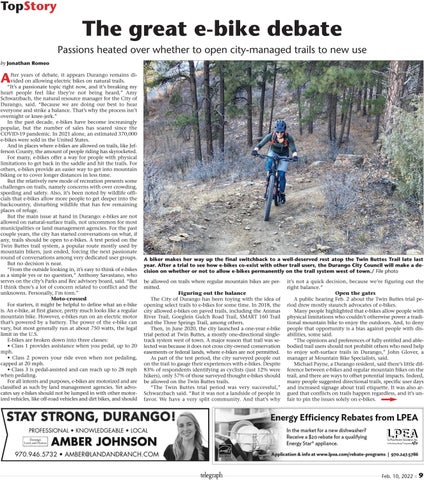TopStory
The great e-bike debate Passions heated over whether to open city-managed trails to new use by Jonathan Romeo
A
fter years of debate, it appears Durango remains divided on allowing electric bikes on natural trails. “It’s a passionate topic right now, and it’s breaking my heart people feel like they’re not being heard,” Amy Schwarzbach, the natural resource manager for the City of Durango, said. “Because we are doing our best to hear everyone and strike a balance. That’s why the process isn’t overnight or knee-jerk.” In the past decade, e-bikes have become increasingly popular, but the number of sales has soared since the COVID-19 pandemic. In 2021 alone, an estimated 370,000 e-bikes were sold in the United States. And in places where e-bikes are allowed on trails, like Jefferson County, the amount of people riding has skyrocketed. For many, e-bikes offer a way for people with physical limitations to get back in the saddle and hit the trails. For others, e-bikes provide an easier way to get into mountain biking or to cover longer distances in less time. But the relatively new mode of recreation presents some challenges on trails, namely concerns with over crowding, speeding and safety. Also, it’s been noted by wildlife officials that e-bikes allow more people to get deeper into the backcountry, disturbing wildlife that has few remaining places of refuge. But the main issue at hand in Durango: e-bikes are not allowed on natural-surface trails, not uncommon for most municipalities or land management agencies. For the past couple years, the city has started conversations on what, if any, trails should be open to e-bikes. A test period on the Twin Buttes trail system, a popular route mostly used by mountain bikers, just ended, forcing the next passionate round of conversations among very dedicated user groups. But no decision is near. “From the outside looking in, it’s easy to think of e-bikes as a simple yes or no question,” Anthony Savastano, who serves on the city’s Parks and Rec advisory board, said. “But I think there’s a lot of concern related to conflict and the unknowns. Personally, I’m torn.” Moto-crossed For starters, it might be helpful to define what an e-bike is. An e-bike, at first glance, pretty much looks like a regular mountain bike. However, e-bikes run on an electric motor that’s powered by a battery. The power of the e-bike can vary, but most generally run at about 750 watts, the legal limit in the U.S. E-bikes are broken down into three classes: • Class 1 provides assistance when you pedal, up to 20 mph. • Class 2 powers your ride even when not pedaling, capped at 20 mph. • Class 3 is pedal-assisted and can reach up to 28 mph when pedaling. For all intents and purposes, e-bikes are motorized and are classified as such by land management agencies. Yet advocates say e-bikes should not be lumped in with other motorized vehicles, like off-road vehicles and dirt bikes, and should
A biker makes her way up the final switchback to a well-deserved rest atop the Twin Buttes Trail late last year. After a trial to see how e-bikes co-exist with other trail users, the Durango City Council will make a decision on whether or not to allow e-bikes permanently on the trail system west of town./ File photo be allowed on trails where regular mountain bikes are permitted. Figuring out the balance The City of Durango has been toying with the idea of opening select trails to e-bikes for some time. In 2018, the city allowed e-bikes on paved trails, including the Animas River Trail, Goeglein Gulch Road Trail, SMART 160 Trail and the Three Springs Trail, among others. Then, in June 2020, the city launched a one-year e-bike trial period at Twin Buttes, a mostly one-directional singletrack system west of town. A major reason that trail was selected was because it does not cross city-owned conservation easements or federal lands, where e-bikes are not permitted. As part of the test period, the city surveyed people out on the trail to gauge their experiences with e-bikes. Despite 83% of respondents identifying as cyclists (just 12% were hikers), only 57% of those surveyed thought e-bikes should be allowed on the Twin Buttes trails. “The Twin Buttes trial period was very successful,” Schwarzbach said. “But it was not a landside of people in favor. We have a very split community. And that’s why
telegraph
it’s not a quick decision, because we’re figuring out the right balance.” Open the gates A public hearing Feb. 2 about the Twin Buttes trial period drew mostly staunch advocates of e-bikes. Many people highlighted that e-bikes allow people with physical limitations who couldn’t otherwise power a traditional mountain bike to enjoy the outdoors. And, to deny people that opportunity is a bias against people with disabilities, some said. “The opinions and preferences of fully entitled and ablebodied trail users should not prohibit others who need help to enjoy soft-surface trails in Durango,” John Glover, a manager at Mountain Bike Specialists, said. Michael Payne, a Durango resident, said there’s little difference between e-bikes and regular mountain bikes on the trail, and there are ways to offset potential impacts. Indeed, many people suggested directional trails, specific user days and increased signage about trail etiquette. It was also argued that conflicts on trails happen regardless, and it’s unfair to pin the issues solely on e-bikes.
Feb. 10, 2022 n
9



